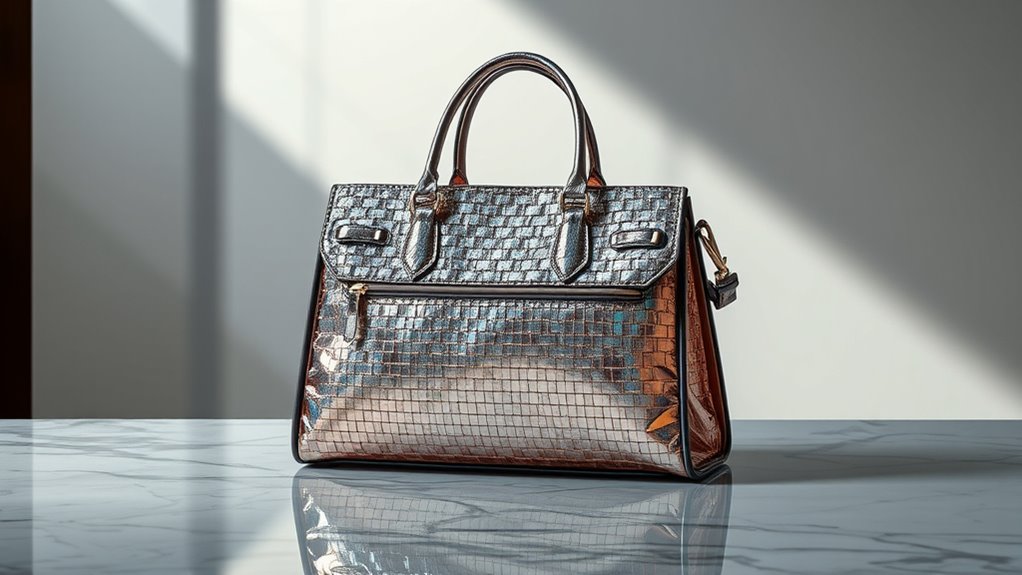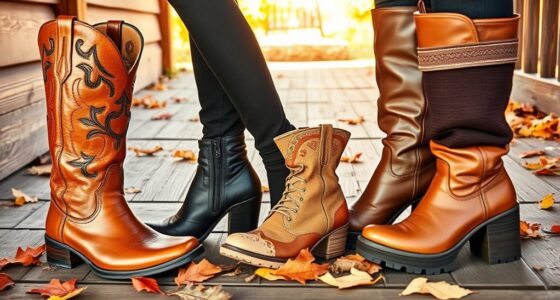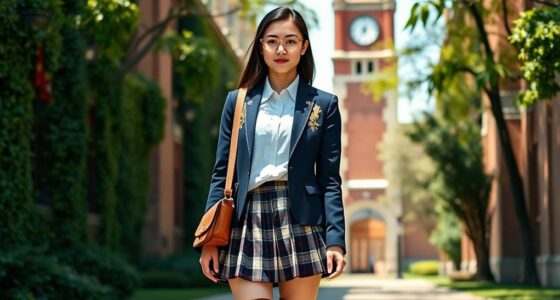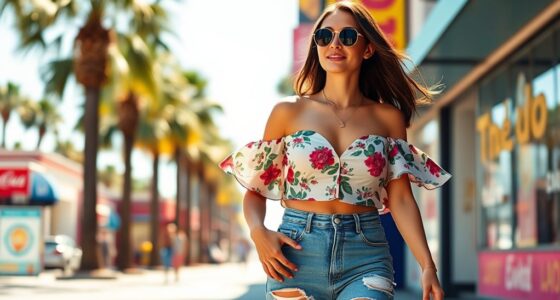Waste is now a top symbol of luxury because upcycled fashion transforms discarded materials into exclusive, stylish pieces that showcase sustainability and craftsmanship. By choosing upcycled luxury, you align with a movement that values responsible consumption and celebrates creativity in waste conversion. This shift redefines worth, making waste a desirable, eco-conscious statement of status. If you want to understand how waste became a symbol of prestige, explore further to uncover the story behind this transformative trend.
Key Takeaways
- Waste is transformed into exclusive, high-quality fashion pieces, elevating upcycled luxury as a desirable status symbol.
- Consumers value the story and sustainability behind each item, redefining luxury ownership beyond rarity alone.
- Upcycled luxury brands support the circular economy, turning discarded materials into sought-after, eco-friendly products.
- Unique craftsmanship and innovative design make waste-based pieces highly desirable and synonymous with modern luxury.
- Supporting upcycled luxury promotes ethical, responsible consumption, positioning waste as a symbol of style and social consciousness.

Luxury is no longer just about exclusivity and high price tags; it’s also about sustainability and innovation. Today, upcycled luxury embodies this shift, turning waste into desirable, one-of-a-kind pieces that elevate your style while making a statement. As someone passionate about fashion, you understand that the industry’s impact on the environment can’t be ignored. That’s why sustainable fashion, which emphasizes the reuse and repurposing of materials, is gaining traction among the most discerning consumers. Upcycling takes this approach a step further, transforming discarded fabrics and objects into luxurious, high-quality products. You’re not just wearing a designer piece—you’re participating in a movement that champions the circular economy, where waste is minimized, and resources are kept in use for as long as possible.
In the world of upcycled luxury, waste becomes the most wanted status symbol. Brands are now sourcing leftover textiles, vintage garments, and industrial scraps to craft unique items that tell a story. Instead of contributing to landfill overflow, you find yourself wearing something that embodies creativity and responsibility. This shift appeals to your desire to stand out, not just for the design but also for its ethical backbone. The circular economy is fundamental here; it promotes a closed-loop system where materials are continually reused, reducing the need for new raw resources. By choosing upcycled luxury pieces, you’re supporting this model—helping to reduce environmental degradation while enjoying exclusive, innovative fashion. Incorporating recycling techniques into design processes further enhances the appeal and sustainability of these creations.
You might notice that upcycled luxury isn’t just about sustainability; it’s about innovation. Designers are pushing boundaries, blending traditional craftsmanship with modern techniques to create stunning, one-of-a-kind pieces. These items often feature intricate details, highlighting the craftsmanship involved in repurposing materials. When you wear upcycled luxury, you’re not just making a fashion statement—you’re making a statement about your values. You’re showing that you care about the planet and support a future where luxury and responsibility coexist. This attitude elevates your style, positioning you as someone aware of the bigger picture and enthusiastic to make a difference.
Ultimately, upcycled luxury redefines what it means to own something valuable. It’s no longer solely about rarity or brand name but also about the story behind each piece and its contribution to a more sustainable world. As you embrace this trend, you become part of a movement that challenges the traditional notions of luxury, proving that waste can truly become the most wanted status symbol. Additionally, many brands are now offering sustainable production practices, which further underscores the importance of responsible consumption in luxury fashion.
Frequently Asked Questions
How Does Upcycled Luxury Impact Traditional Fashion Sustainability Efforts?
You see, upcycled luxury challenges traditional fashion sustainability by emphasizing sustainable sourcing and ethical craftsmanship. It pushes brands to repurpose waste, reducing environmental harm while maintaining quality. This approach encourages consumers to value eco-conscious practices, making sustainability a status symbol. As you support upcycled luxury, you promote a shift toward more responsible production, inspiring brands to prioritize sustainability efforts and redefine luxury through waste reduction and ethical innovation.
What Are the Main Challenges in Designing Upcycled Luxury Products?
When designing upcycled luxury products, you face challenges like sourcing quality materials that guarantee durability and appeal. You also need to master craftsmanship techniques that transform waste into high-end items, which can be time-consuming and require specialized skills. Balancing creativity with sustainability standards pushes you to innovate constantly, making sure each piece maintains luxury appeal while staying eco-friendly. These hurdles demand dedication and expertise to succeed in the upcycled luxury market.
Can Upcycled Luxury Items Maintain Their Value Over Time?
You might wonder if upcycled luxury items can hold their value over time. With their vintage appeal, these pieces often become sought-after collectibles, enhancing their investment potential. By emphasizing craftsmanship and unique stories behind each item, you can boost their long-term worth. While trends change, the rarity and sustainability of upcycled luxury can help maintain their desirability and value, making them a smart, stylish investment for the future.
How Do Consumers Verify the Authenticity of Upcycled Luxury Goods?
Imagine holding a rare gem; you’d want to be sure it’s genuine. To verify the authenticity of upcycled luxury goods, you rely on authenticity verification methods like detailed provenance and craftsmanship checks. Certification standards serve as your trusted map, guiding you through the maze of fakes. Always seek verified labels, transparent documentation, and reputable sellers—these are your keys to confidently owning a piece that’s truly upcycled luxury.
What Are the Future Trends for Upcycled Luxury in High Fashion?
You’ll see upcycled luxury in high fashion becoming even more innovative, driven by a circular economy. Designers will prioritize ethical sourcing, using sustainable materials that reduce waste. Expect brands to embrace transparency, showcasing their eco-friendly processes and inspiring consumers to make conscious choices. This trend will elevate the status of upcycled pieces, making them not just stylish but also a statement of environmental responsibility and forward-thinking fashion.
Conclusion
As you embrace the upcycled luxury trend, you’re not just making a stylish statement but also turning waste into a true treasure. It’s clear that what’s old can become new again, proving that one person’s trash really can be another’s treasure. By choosing sustainable elegance, you’re staying ahead of the curve and proving that sometimes, the best things in life are worth the wait. After all, beauty is in the eye of the beholder—and now, in the hands of the conscious consumer.









